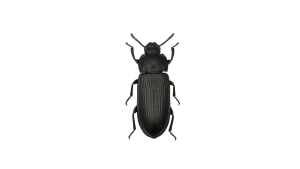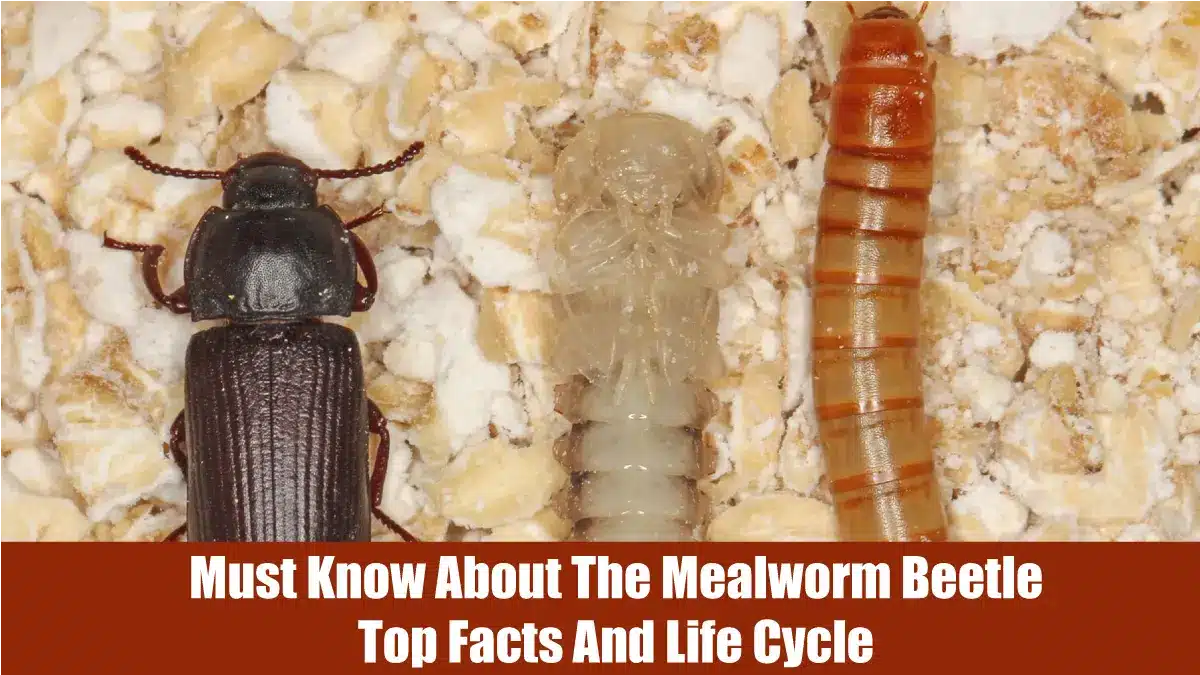The yellow mealworm beetle, Tenebrio molitor, let me tell you, it’s a darkling beetle that can be found in Europe, Asia, and North America. It’s like, all over the place, you know?
It is widely used in animal feed and human consumption as a protein and nutrition source!
Mealworm larvae are super versatile! They are protein-packed and can be used in pet food, poultry, and aquaculture.
This environmentally friendly and sustainable alternative to standard animal feed has gained immense popularity in recent years!
The article delves into the mealworm beetle’s life cycle, habitat, nutrition, and uses.
Studying the mealworm beetle reveals its significance to the animal feed industry and environmental sustainability.
Table of Contents
What Is A Mealworm Beetle?
The mealworm beetle, Tenebrio molitor, is a common Tenebrionidae bug. Darkling beetles include it.
Adult mealworm beetles are 1–1.5 cm long. Their strong exoskeleton is dark brown to black.
Mealworm beetles have strong elytra that protect their hind wings. The elytra have longitudinal ridges.
A head, thorax, and abdomen distinguish the mealworm beetle. Beetles have six legs and two antennae for sensory awareness.
Mealworm beetles inhabit North America, Europe, and Asia. In gardens and fields, they eat decomposing organic waste.
Life Cycle Of Yellow Mealworm Beetle
Egg Stage
The mealworm beetle starts its life cycle with the egg stage. The eggs of the mealworm beetle are very small and have an oval shape.
They measure about 1mm in size. The color of these objects is typically off-white or cream.
The adult female beetles lay these eggs in small groups. They usually bury them in soft soil or hide them in decaying organic matter. The time it takes for an egg to hatch can change based on temperature and the environment.
Eggs usually take about 4 to 19 days to hatch. During this time, the eggs change and grow, gradually becoming larvae.
The egg stage is very important for the life cycle of the mealworm beetle. It is like a starting point for the next stages of its growth.
Larval Stage
Mealworm larvae are the immature stage of the darkling beetle, Tenebrio molitor. Mealworm larvae come from the mealworm beetle, Tenebrio molitor. These creatures measure around 1-2.5 cm in length. They have a body divided into segments and a tough outer covering called an exoskeleton.
Their body color is usually golden-brown, but some individuals might look darker. The larvae use their six small legs near the front of their body to move, but they mainly crawl or wiggle.
Mealworm larvae scavenge and eat many different types of decomposing organic matter. They can feed on things like grains, vegetables, and fruits. They are also known to consume other insects or animal remains if available.
Their diet consists mainly of carbohydrates and fats.
The duration of the mealworm larvae stage can vary depending on environmental conditions. Under optimal temperature and food availability conditions, the larvae can complete their growth in approximately 4-12 weeks.
However, factors like temperature and nutrition can significantly affect their development time.
A higher temperature generally accelerates their growth, while a colder environment slows it down. As they reach the end of their larval stage, mealworms undergo pupation, transforming into adult beetles.
Pupal Stage
The pupal stage is vital for butterflies and moths. The pupa follows the larva in transformation.
During this stage, larvae evolve into adult insects. The larvae secrete a cocoon to protect the pupa.
This cocoon protects the pupa from harm as it develops and evolves. The pupa grows wings, legs, and antennae inside the cocoon.
In histogenesis, pupal tissues differentiate, and organogenesis occurs. The pupal stage length depends on species and habitat. It can last days or months.
A pupa is motionless and does not feed during this stage. It grows stronger and prepares to become an adult butterfly or moth.
Adult Stage
The adult mealworm beetle, or Tenebrio molitor, is a dark brown or black insect around 1.25 centimeters long. It has a hard exoskeleton, six jointed legs, and a pair of short antennae on its head.
The adult beetle has fully developed wings, but they are non-functional and cannot be used for flying.
Reproduction in mealworm beetles involves a process called copulation. Males and females come together and engage in a courtship ritual. The male beetle mounts the female from behind and transfers sperm to her reproductive tract.
The female then lays small, oval-shaped eggs around 1 millimeter long. These eggs are typically laid in a dark and warm environment, such as inside a bed of suitable substrate.
A mealworm beetle’s adult stage lasts about 3 to 5 months. During this time, the beetles undergo several molts, shedding their exoskeletons and growing larger.
They will also consume a diet primarily consisting of grains, fruits, and vegetables.
As they age, their exoskeletons become darker and harder. In optimal conditions, mealworm beetles can live up to a year.
Interesting Facts About Mealworm Beetles

The mealworm beetle, known as Tenebrio molitor, exhibits unique adaptations and survival strategies that make it an interesting insect.
One of its remarkable adaptations is its ability to live off a diet of decaying plants and grains, making it an excellent ecological decomposer.
Furthermore, mealworm beetles have a hard exoskeleton that protects them from predators and environmental conditions. They also have a distinct defense mechanism of secreting foul-smelling chemicals when threatened.
This adaptation helps deter potential predators from attacking them. Regarding interaction with the environment, mealworm beetles play a crucial role in ecosystems as decomposers.
They break down organic matter, contributing to nutrient cycling and soil enrichment. Additionally, these beetles provide food for other organisms, such as birds, reptiles, and small mammals.
Overall, the mealworm beetle’s unique adaptations and role in ecosystems make it a fascinating and important insect in the natural world.
Importance Of Beetles
Mealworm beetles have important uses and contributions to different industries and ecological processes.
Commercially, mealworm beetles are utilized in livestock feed and pet food.
Their larvae, mealworms, are protein-rich and nutritious for poultry, fish, and reptiles.
This makes mealworm beetles vital to the worldwide livestock economy since they feed animals sustainably and cheaply.
Mealworm beetles also recycle nutrients and decompose.
They break down fruits, vegetables, and cereals into simpler components and replenish environmental nutrients.
This promotes organic matter breakdown and soil nutrient recycling, sustaining a healthy ecosystem.
Thus, mealworm beetles are commercially valuable and essential for sustainable waste management and ecological balance.
Mealworm Life Stages Beetles Video
Conclusion
The mealworm beetle is a fascinating insect with a complete metamorphosis life cycle.
Starting as an egg, it transitions through larval, pupal, and adult stages. As a larva, it is a valuable source of protein for animal feed.
The adult beetle plays an important ecological role as a decomposer.
Mealworm beetles exhibit unique adaptations like a tough exoskeleton and chemical defenses.
Their ability to consume decaying matter contributes to nutrient cycling in the environment.
Commercially, mealworms support the livestock and pet food industries as a sustainable protein source.
The humble mealworm beetle may seem small, but it has an outsized impact.
Understanding its life cycle and ecology reveals the interconnectedness and complexity of nature.
Mealworm beetles exemplify how insects can simultaneously fill commercial, ecological, and scientific niches.
FAQ.s
What is a mealworm beetle?
A mealworm beetle, also known as a darkling beetle, is a species of darkling beetle scientifically called “Tenebrio molitor.” It is the adult form of the mealworm, which is the beetle’s larval stage.
What does a mealworm beetle look like?
The mealworm beetle is a small beetle that measures about 1.25 to 1.8 inches long. It has a dark brown or black color and a hard exoskeleton. The beetles belong to the Tenebrionidae family.
What is the life cycle of mealworm beetle?
The life cycle of a mealworm beetle consists of four stages: egg, larva, pupa, and adult. The beetles lay their eggs in grain or other food sources. The eggs hatch into larvae, which are the mealworms. The larvae go through four molts and grow larger until they enter the pupal stage. After the pupal stage, the adult beetles emerge.
What do mealworm larvae typically look like?
Mealworm larvae typically measure about 2.5 cm long. They are yellowish-brown in color and have a cylindrical shape with six tiny legs near their head. The larvae are often found in areas with decaying organic matter or grain products.
How are mealworms and mealworm beetles used?
Mealworms are typically a food source for reptiles, birds, and small animals. They are also commonly used in pet food and as bait for fishing. Mealworm beetles, on the other hand, are not commonly used for any specific purpose but are part of the natural life cycle of the mealworm.
Can mealworms be a pest or cause infestations?
Yes, mealworms can be considered pests if they infest stored grain or other food products. They can cause damage and contamination. Preventing and controlling mealworm infestations is important, especially in agricultural or storage settings.
How do mealworm beetles lay their eggs?
Mealworm beetles lay their eggs in grain, flour, bran, or other similar food sources. They prefer areas where the larvae have plenty of food to eat and grow. The eggs are small and difficult to see without magnification.
Related Articles
What are Dermestid Beetles, is it a cleanup crew for nature?
Discover The Threat: Cigarette Beetles And Drugstore Beetles Explained
What’s That Gold Beetle? Secrets Of Charidotella Sexpunctata
Water Beetles Diving Deeper: Exploring The Survival Tactics!
